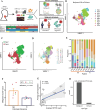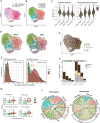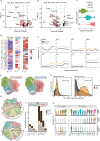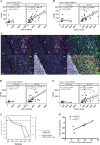Single-cell analysis reveals cellular and molecular factors counteracting HPV-positive oropharyngeal cancer immunotherapy outcomes
- PMID: 38857913
- PMCID: PMC11168198
- DOI: 10.1136/jitc-2023-008667
Single-cell analysis reveals cellular and molecular factors counteracting HPV-positive oropharyngeal cancer immunotherapy outcomes
Abstract
Background: Oropharyngeal squamous cell carcinoma (OPSCC) induced by human papillomavirus (HPV-positive) is associated with better clinical outcomes than HPV-negative OPSCC. However, the clinical benefits of immunotherapy in patients with HPV-positive OPSCC remain unclear.
Methods: To identify the cellular and molecular factors that limited the benefits associated with HPV in OPSCC immunotherapy, we performed single-cell RNA (n=20) and T-cell receptor sequencing (n=10) analyses of tonsil or base of tongue tumor biopsies prior to immunotherapy. Primary findings from our single-cell analysis were confirmed through immunofluorescence experiments, and secondary validation analysis were performed via publicly available transcriptomics data sets.
Results: We found significantly higher transcriptional diversity of malignant cells among non-responders to immunotherapy, regardless of HPV infection status. We also observed a significantly larger proportion of CD4+ follicular helper T cells (Tfh) in HPV-positive tumors, potentially due to enhanced Tfh differentiation. Most importantly, CD8+ resident memory T cells (Trm) with elevated KLRB1 (encoding CD161) expression showed an association with dampened antitumor activity in patients with HPV-positive OPSCC, which may explain their heterogeneous clinical outcomes. Notably, all HPV-positive patients, whose Trm presented elevated KLRB1 levels, showed low expression of CLEC2D (encoding the CD161 ligand) in B cells, which may reduce tertiary lymphoid structure activity. Immunofluorescence of HPV-positive tumors treated with immune checkpoint blockade showed an inverse correlation between the density of CD161+ Trm and changes in tumor size.
Conclusions: We found that CD161+ Trm counteracts clinical benefits associated with HPV in OPSCC immunotherapy. This suggests that targeted inhibition of CD161 in Trm could enhance the efficacy of immunotherapy in HPV-positive oropharyngeal cancers.
Trial registration number: NCT03737968.
Keywords: Head and Neck Cancer; Immune Checkpoint Inhibitor; Immunotherapy; Tumor microenvironment - TME; co-inhibitory molecule.
© Author(s) (or their employer(s)) 2024. Re-use permitted under CC BY-NC. No commercial re-use. See rights and permissions. Published by BMJ.
Conflict of interest statement
Competing interests: None declared.
Figures





References
-
- Burtness B, Harrington KJ, Greil R, et al. . Pembrolizumab alone or with chemotherapy versus cetuximab with chemotherapy for recurrent or metastatic squamous cell carcinoma of the head and neck (KEYNOTE-048): a randomised, open-label, phase 3 study. Lancet 2019;394:1915–28. 10.1016/S0140-6736(19)32591-7 - DOI - PubMed
MeSH terms
Substances
Associated data
LinkOut - more resources
Full Text Sources
Other Literature Sources
Medical
Molecular Biology Databases
Research Materials
